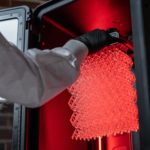The new Stratasys’ Origin One allows mass production of end-use parts and functional prototypes. Designed with users in mind, Origin One is an open-source material printer, giving users a vast selection of materials. The Origin One can complete production jobs quickly, while still being cost effective.

The Technology
Mass production of end-use parts has been made possible on the Origin One due to Programmable Photopolymerization (P3). P3 builds on DLP technology, taking what DLP could do and bringing it to next generation of production parts made with photopolymers.
There are a few factors that enable P3 to achieve high throughput, production-grade parts, including: light, environmental stability, pneumatic separation, motion, and green strength. If you’d like to learn more about P3 technology, then click here.

The Origin One
With a build envelope of 192 x 108 x 370 mm, and quick print times, the Origin One achieves optimum efficiency. This means your team can maximize your production capacity per square foot.
As an open source printer, the Origin One allows you to find the exact right material for your application. Stratasys works with leading chemical companies, like LOCTITE and DSM, to co-develop innovative photopolymers, unlocking end-use 3D printing applications. This gives users a wide range of single component, commercial-grade materials validated for the Origin One.
The Materials
From automotive to medical, Origin One has a material fit for the job. Here’s some of our favorites:
- Dura56 – A low-cost material with exceptional surface finish and a 78% elongation at break. Dura56 was used in a test where the printed parts were being used to build a functional scooter. The scooter ended up working just the same as a traditional manufactured scooter.
- MED412 – A clear medical-grade certified resin that’s biocompatible. At the start of the pandemic, MED412 was used to mass-produce COVID-19 testing swabs.
- LOCTITE 3D IND402 – Material with exceptional durability to compression forces and true elastomeric behavior. In 2020, the U.S. Air Force hosted an open competition to find new and creative 3D printing solutions for the C3175 family of hydraulic line clamps. Stratasys won the competition using IND402.
- Ultracur3D ST45 – This material has a balanced combination of strength, toughness, and surface finish, with the bonus of very fast printing and post-processing. A company designed camera mounts for CNC machining, but the process was time consuming and costly. They decided to print the part on the Origin One, where 40 camera mounts were made in less than 8 hours.
To learn more about the possibilities with Origin One let us know. Our team is happy to help you find the right solution for your needs. You can reach out to us by email at [email protected] or by phone at 949.474.9222.


Meet Saxon Swart
Meet Purple Platypus Marketing Specialist, Saxon Swart. Saxon helps the marketing team with photo and video content. His favorite part about working about Purple is the friendly environment of the office.
Out of the office, Saxon enjoys playing tennis, reading, and talking with friends. If you haven’t had the chance to meet Saxon yet, connect with him on LinkedIn or stop by our office and say hi!
Related Articles You May Enjoy

Why FDM And PolyJet Are Essential Technologies
I have been in the 3D printing industry since 2013. I’ve seen how trends come and go, new technologies promise to be a silver bullet, and how everyone is holding

From Napkin to 3D Model: CAD Design with Purple Porcupine
Do you have the next best toy to hit the shelves? Are you the trendsetter developing the newest craze? Or are you simply diagnosing a problem and determined to create

Multi-Material Printing with PolyJet
Creating unique and visually stunning prototypes has never been easier. For simple prototypes, Stratasys PolyJet machines generate detailed and effective models. But with projects requiring multi-body assemblies, full-color options, and





